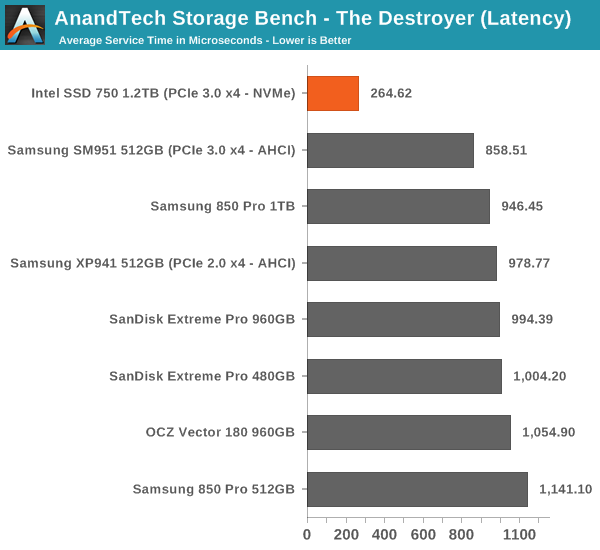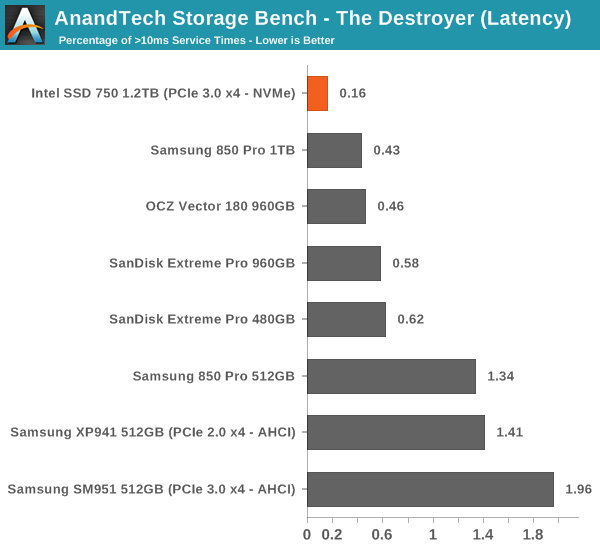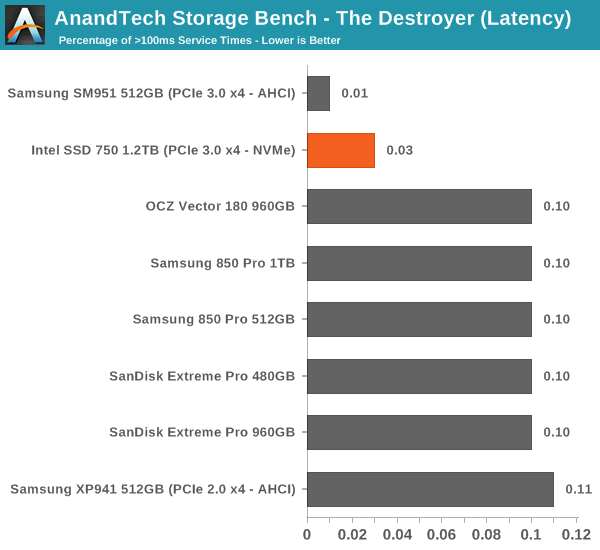Intel SSD 750 PCIe SSD Review: NVMe for the Client
by Kristian Vättö on April 2, 2015 12:00 PM ESTAnandTech Storage Bench - The Destroyer
The Destroyer has been an essential part of our SSD test suite for nearly two years now. It was crafted to provide a benchmark for very IO intensive workloads, which is where you most often notice the difference between drives. It's not necessarily the most relevant test to an average user, but for anyone with a heavier IO workload The Destroyer should do a good job at characterizing performance.
| AnandTech Storage Bench - The Destroyer | ||||||||||||
| Workload | Description | Applications Used | ||||||||||
| Photo Sync/Editing | Import images, edit, export | Adobe Photoshop CS6, Adobe Lightroom 4, Dropbox | ||||||||||
| Gaming | Download/install games, play games | Steam, Deus Ex, Skyrim, Starcraft 2, BioShock Infinite | ||||||||||
| Virtualization | Run/manage VM, use general apps inside VM | VirtualBox | ||||||||||
| General Productivity | Browse the web, manage local email, copy files, encrypt/decrypt files, backup system, download content, virus/malware scan | Chrome, IE10, Outlook, Windows 8, AxCrypt, uTorrent, AdAware | ||||||||||
| Video Playback | Copy and watch movies | Windows 8 | ||||||||||
| Application Development | Compile projects, check out code, download code samples | Visual Studio 2012 | ||||||||||
The table above describes the workloads of The Destroyer in a bit more detail. Most of the workloads are run independently in the trace, but obviously there are various operations (such as backups) in the background.
| AnandTech Storage Bench - The Destroyer - Specs | ||||||||||||
| Reads | 38.83 million | |||||||||||
| Writes | 10.98 million | |||||||||||
| Total IO Operations | 49.8 million | |||||||||||
| Total GB Read | 1583.02 GB | |||||||||||
| Total GB Written | 875.62 GB | |||||||||||
| Average Queue Depth | ~5.5 | |||||||||||
| Focus | Worst case multitasking, IO consistency | |||||||||||
The name Destroyer comes from the sheer fact that the trace contains nearly 50 million IO operations. That's enough IO operations to effectively put the drive into steady-state and give an idea of the performance in worst case multitasking scenarios. About 67% of the IOs are sequential in nature with the rest ranging from pseudo-random to fully random.
| AnandTech Storage Bench - The Destroyer - IO Breakdown | |||||||||||
| IO Size | <4KB | 4KB | 8KB | 16KB | 32KB | 64KB | 128KB | ||||
| % of Total | 6.0% | 26.2% | 3.1% | 2.4% | 1.7% | 38.4% | 18.0% | ||||
I've included a breakdown of the IOs in the table above, which accounts for 95.8% of total IOs in the trace. The leftover IO sizes are relatively rare in between sizes that don't have a significant (>1%) share on their own. Over a half of the transfers are large IOs with one fourth being 4KB in size.
| AnandTech Storage Bench - The Destroyer - QD Breakdown | ||||||||||||
| Queue Depth | 1 | 2 | 3 | 4-5 | 6-10 | 11-20 | 21-32 | >32 | ||||
| % of Total | 50.0% | 21.9% | 4.1% | 5.7% | 8.8% | 6.0% | 2.1% | 1.4% | ||||
Despite the average queue depth of 5.5, a half of the IOs happen at queue depth of one and scenarios where the queue depths is higher than 10 are rather infrequent.
The two key metrics I'm reporting haven't changed and I'll continue to report both data rate and latency because the two have slightly different focuses. Data rate measures the speed of the data transfer, so it emphasizes large IOs that simply account for a much larger share when looking at the total amount of data. Latency, on the other hand, ignores the IO size, so all IOs are given the same weight in the calculation. Both metrics are useful, although in terms of system responsiveness I think the latency is more critical. As a result, I'm also reporting two new stats that provide us a very good insight to high latency IOs by reporting the share of >10ms and >100ms IOs as a percentage of the total.

In terms of throughput, the SSD 750 is actually marginally slower than the SM951, although when you look at latency the SD 750 wins by a large margin. The difference in these scores is explained by Intel's focus on random performance as Intel specifically optimized the firmware for high random IO performance, which does have some impact on the sequential performance. As I've explained above, data rate has more emphasis on large IO size transfers, whereas latency treats all IOs the same regardless of their size.

The number of high latency IOs is also excellent and in fact the best we have tested. The SSD 750 is without a doubt a very consistent drive.












132 Comments
View All Comments
p1esk - Friday, April 3, 2015 - link
Let me say that again: this is a consumer drive. That's why it is so cheap compared to 3700. A large Hollywood production company will surely be able to afford enough of these drives not to worry about exceeding 128TB write limits.emn13 - Saturday, April 4, 2015 - link
I'm sure they can afford it - but why pay more than necessary? Compared to the competition, this is an unusally low write endurace for such a high-end drive. Take a peek at say the 1TB 850 Pro; that's likely to be considerably cheaper (and perhaps more deserving of the "consumer" monniker), and it's NAND is rated for a little more than 6000TB of (raw) writes.128TB? That's really, really unusual for a drive like this.
earl colby pottinger - Tuesday, April 7, 2015 - link
Because that is how you run your company out of business by being cheap of key hardware.If you are producing enough 4K video to stress this drive, you are producing enough video that the cost of production is way greater that the cost of drives that you don't have to worry about this type of failure.
I have seen tons of companies go out of business or lose out on thousands of dollars in sales because they tried to save a few hundred dollars up-front against my advice.
Stop looking for cheap solutions if the storage is critical to the running of your business.
emn13 - Saturday, April 4, 2015 - link
I do a lot of large-file snapshot/restore stuff, and I definitely write a lot more than 70gb a day. Intel's own consumer level 335 was rated for 700TB, and that was a much smaller drive. More specifically, this hasn't been a problem on other drives - neither on ssd's, nor on hdds. While it's conceivable there are more efficient ways of working from the perspective of the drive, that's a hassle to arrange.Perhaps it's worth pointing you to the SSD endurance experiment: http://techreport.com/review/26523/the-ssd-enduran...
All of these drives approximately 240GB drives survived at least 700gb, and it was specifically the intel that seemingly intentionally bricked itself then.
This drive is 5 time larger, and is rated for a fraction of that. This is pretty unreasonable to my mind.
darkgreen - Thursday, April 2, 2015 - link
This part of the review made be curse:"...with the X25-M. It wasn't the first SSD on the market, but it was the first drive that delivered the aspects we now take for granted: high, consistent and reliable performance."
Arrrgh...
I was one of the early adopters who paid a ton for the XM-25. If you go back through the archives, though, you'll see Intel's XM-25 had a fragmentation bug that made it slower than a spinning platter hard drive after a bit of use. I was in that situation. Intel released a "fix" based on a script run on some old freeware, but they didn't support the fix *at all* and for many people (including me) it would never work.
So INTEL's "high, consistent and reliable performance" turned out to be total crap. I paid over $400 for what turned out to be a doorstop and had to replace it with a Corsair SSD a short time later. INTEL never offered a refund, support, or even an apology to all the people they had sold a totally nonfunctional product to. I still have that drive in my electronic junk pile and I curse INTEL every time it catches my eye.
I'm waiting for good PCIe SSD before my next PC build, unfortunately I would say INTEL products don't count because in the past we've seen (inarguably, and documented on this very site!) that they mass release buggy products and if you happen to have bought one you're just hung out to dry when they turn out to have had major design errors.
Ugh. at least mention the history here and caution people instead of suggesting Intel is reliable.
Makaveli - Thursday, April 2, 2015 - link
anecdotal evidence!!I've have two G2 160GB intel drives in Raid 0 for a couple years now and they been solid no issues.
So I disagree with your post do I win ?
darkgreen - Friday, April 3, 2015 - link
I wasn't expected that kind of reply. Google "intel replicated SSD firmware problem" (without the quotes) and you can read about the various things that happened, many of which were first reported at this very site, but I guess it WAS 6 years ago so I shouldn't expect everyone to know about it.I was running win 7 64-bit and had a G1. You'll see reports that ALL G1's had a fragmentation issue that made them slower than spinning platters after a bit of use, and you'll see mainstream media reports about how the "fix" instead bricked drives for many users on win 7 64-bit .
Not anecdotes, mainstream reporting and I was one of the thousands affected and can confirm that even after those reports Intel did nothing for non-enterprise users but delete the 50-page thread on their support site.
Kristian Vättö - Thursday, April 2, 2015 - link
To put it frankly, there's no SSD (or HDD) manufacturer that hasn't had any issues, so you might as well go back to the good ol' pen&paper if you want something truly reliable ;-)Raniz - Thursday, April 2, 2015 - link
Until the pen explodes and you have to buy a new shirtdarkgreen - Friday, April 3, 2015 - link
Agreed. In coming up with a good google search for the guy above who apparently hadn't heard about this I encountered a lot of articles about necessary firmware updates for other vendors as well. All I know is that Intel left consumers without options or replacements, I don't know what happened in all those other cases. I suppose it's a good reason to think about how important the storage division is to any company you buy from, though. Intel might, conceptually, want to support SSDs but I'd imagine all the management focus is on enterprise and processors. So who do you go with? OCZ (yikes! but maybe okay after the buyout?) Any thoughts on which companies actually value consumer purchases of their SSDs as "mission-critical" ?